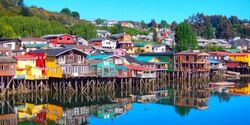While Kanjor is a united nation-state it contains several rich, and diverse cultures. Kanjorien culture is a mix of Selucian colonial culture (especially from the island of Aquilonia) with elements of indigenous (primarily Willitu) elements as well as cultural influences brought by immigrants, especially from other Canrillaise nations. While the dominant ethnic group is the Canrillaise-Kanjorien, the different regions of Kanjor developed their own unique cultures based upon their geographic location. These many cultural differences can be categorized into two groups: culture of the Mainland, and culture of the Isle of la Tondelle. Both of these groups contain many smaller and localized cultural traits, but it is possible to summarize each group's characteristics into a single but separate "culture" for both of these main regions.
Basic Lifestyle[]

The 950 person village of Saint-Arnaud de Colbert. Despite its medium population, most of the people of Kanjor live in small towns and villages of 5,000 or less.
Kanjor has a medium-sized population of under 60 million. Most Kanjoriens live in relatively small towns and villages of 5,000 or less. Kanjoriens have been described as having a laid back lifestyle, with a tradition of taking long lunch breaks during the day and returning to work before going out for drinks. They are however considered hardworking, most have no-nonsense attitude toward work. Kanjoriens are able to separate work and outside work lives, and are heavy drinkers of wines, beers, and aigardent made from distilled grapes. They are also highly social, enjoying theater, concerts, operas, good food, and family dinners on Sundays. Kanjorien cities tend to be compact and public transportation is used frequently.
Cuisine[]
Kanjorien cuisine can be defined as a mixture of Majatran and Artanian influences brought by the Selucians and local Willitu elements, using local ingredients.
Kanjor, just like Rildanor to the north, strongly identifies with and maintains their unique cuisine. However, unlike in Rildanor, Kanjorien cuisine has much less focus on presentation and instead emphasizes
varies between régions of Kanjor.
less emphasis on presentation compared to Rildanor;
Wines, Beers, and Liqueurs[]
- as diverse as the cuisine, depends on region
- cider is big; apples grown on Isle and in Martois
- apple brandies
- wine is more common in Oléri-des-Grâces (proximity to Rildanor) and big cities
- fruit liqueurs (esp. apples, cherries, berries), nut-flavored liqueurs, some herbal liqueurs (Oléri-des-Grâces)
- mead (from honey with spices) found in western Numineux
- beer drunk everywhere; most domestic beers (saisons) are low-alcohol pale ales that are slightly fruity & spicy in flavor; served in large blue bottles like wine
- also, kriek beer (fermented with sour cherries) brewed in Numineux
The Arts[]
Visual Arts[]
Literature[]
Music[]
Entertainment[]
Television[]
Most Kanjoriens tend to watch a minimal amount of TV and so therefore the original programming is not as common nor as sophisticated as many foreign programs. Because of this, Kanjor has only 15 major channels which are presented over the air and few places have access to cable programing.
Highest rated television shows:
- L'interrègne is a drama about a family living during the Interregnum of the 1950s; conceived as a limited series traversing the 100 years of the interregnum and its affect on the family
- Le bureau is a comedy taking place in the workplace of a fictional government bureaucracy office

Publicity photo of the major characters of the La confidentielles television series.
- La confidentielles is a police action-drama hovering around a major crimes unit in Pesançon; it is known for its vivid portrayal of street violence and crime; shocking for most Kanjoriens
- Le badge is a police drama hovering around a smalltown police force, the crimes and the lives of the people they affect
- La Vie des Colombes is a drama round a modern Kanjorien family with particular focus on the adolescent and teenage characters
Stations[]
- Télévision Canrillaise-Kanjorien (TCK) - state-owned; entertainment, sports, movies, and news channel; primary channel
- Kanjor 2 (K2) - state-owned; children shows, educational, home improvement, documentary, news analyses, discussion programs
- Kanjor 3 (Trois)- state-owned; arts, opera, movies, cultural programming
- Kanjor régional (KR) - private; regional news, regional entertainment, original and foreign programming
- Chaîne métropolitaine (Métro) - private; entertainment, movies, original and foreign programming; based in Pesançon
- Chaîne information (Info) - private; 24-hour news, news analyses, discussion programs
- Sport kanjor (Sport) - private; 24-hour foreign and domestic sports; regional sports as well
- Divertissement à domicile (DD) - private; package-purchased cinema, original programing
- Chaîne discothèque (Disco) - private; entertainment and music station
Film[]
Studios de cinéma national[]
- Partial government owned and government supported film studio; biggest studio
- produces and releases over 70 films a year
- known for comedies, romance films, live-action and animated children's movies; light dramas
Studio Saint-Claire[]
- Private studio
- produces and releases roughly 18 films a year

Director Luc Lyon, the most famous, successful and arguably the best film director in the history of Kanjorien cinema.
- known for high quality films, esp. dramas; win most Kanjorien film awards; movies do only mediocre at the box office
- legendary director Luc Lyon worked there; "made" the studio with his films even though got paid less than if he worked at national cinema
Studio Pesançonnois[]
- private studio
- produces and releases roughly 12 films a year
- known for gritty, serious, or action films; crime drama films;
- award-winning computer animated children's films; has only made 4 but considered cultural icons
- Trademark use of Pesançon as the backdrop to most films
Art indépendant[]
- partially private, partially government of Silliers own
- produces and releases roughly 8 films a year
- known for its artistic or artistic-drama films; so-called "small and independent" films
- many films are considered "culturally Tondelois" and so not very popular in the mainland regions
Sport[]
- Several important and popular sports in Kanjor; many are popular and many are both popular and culturally significant
Rugby
Rugby is the most popular sport in Kanjor but dominates mostly on the Isle of la Tondelle and is considered by many to be the the most culturally significant sport to come out of the nation.
Football

Club Athlétique footballer Pierre-Luc Trezeguet.
- Football is second most popular sport in Kanjor;
- modern incarnation brought from northern Seleyan sailors in port to Kanjor in late 1800s
Cycling

The Tondelois classique professional bicycle day-race.
- cycling most popular on Mainland; although still very popular on Isle
- Every year there is the Tour de Kanjor; biggest and most popular race in nation;
Sailing
- yacht racing and sailing popular amongst elite on the Isle of la Tondelle
- inshore and offshore yacht racing; biggest is the Coupe de la chenal (Channel Race) which spans the entire Silliers Channel in stages and lasts for five days; happens every three years
- over 73 competitions carried out over centuries; Rildanor holds 55, Istalia 10, Kanjor only 8
-

Yacht racing in the Channel.
Education[]
Education in Kanjor walks a fine line between being highly centralized and regional in orientation and organization. Primary and secondary education takes place almost entirely at the regional level, with the national government responsible for funding, regulation, and curriculum design; although the separate regions may create unique curriculum for which to teach about the history and culture of their regions.
Most primary and secondary schools, with the exception of nursery schools which are nationally or privately run and funded, are predominately run by the regions, which are responsible for hiring of teachers and administrators; however, teachers are considered to be national civil servants and are paid by the national government. The nation maintains a compulsory and free primary and secondary education system until children reach the age of 18. There are a small number of private educational institutions, mostly Theognosian in orientation, but they are heavily regulated by the national and regional governments.
The school calendar is created and implemented by the Ministry of Education and Culture and is standardized throughout the nation; however, the Isle of la Tondelle has the ability to change the vacation dates based upon the weather and cultural conditions.
Media[]
Newspapers[]
There are six main newspapers in Kanjor, which have held long-standing political loyalties, and have been actively engaged in endorsing political parties:
L'Héraut is a broadsheet newspaper, with considerable loyalties to the Monarchy, traditional values and the Church. It is the most outspokenly right-wing newspaper in Kanjor, and generally takes a tough line on immigration, social reform and crime. It is broadly nationalistic in tone, and favours economic nationalism over free trade. It has also taken a noted anti-communist line in foreign affairs.
Le Gardien is a broadsheet newspaper, that while declaring itself 'independent' politically, has sympathies for centre-left and liberal causes. It is the paper most likely to promote environmental causes and social reform. It has generally endorsed moderate, centre-left parties, but has also backed right-wing parties with a liberal bent. It is seen as the paper for the liberal middle-classes.
Grève Rouge is a broadsheet newspaper, and has the support of the hard left. It supports militant communism, class struggle and revolution. It is seen as internationalist in foreign affairs, and promotes the idea of a 'world revolution'. It is also supportive of social reform. Its columnists are split between liberals and conservatives over social issues, such as gay marriage and abortion. Its primary concern is an economic struggle.
Les Temps Economiques is a broadsheet newspaper, with a centrist political agenda, and actively promotes free-markets and a small government. It is seen as socially liberal and economically conservative. It has generally supported right-wing governments which promote a smaller role for the government and bureaucracy, and free trade. It is also supportive of globalisation.
Le Journal is a tabloid newspaper, and politically populist. It is known to sensationalise the news, and is generally supportive of the incumbent politically. Many of its opinion pieces are right-wing in nature, but are also skeptical of big business and the middle classes.
Lys D'or is a broadsheet newspapers and official organ of the Royalist movement in Kanjor. In contrast to other Royalist dailies, it is decidedly left-wing and often features views sympathetic to immigrants and the poor. It is the newest newspaper and as such has a relatively lower readership, but the upper and upper-middle classes are seen to have taken the most interest in it.
